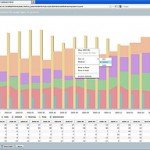Choosing the 'right' KPI's to manage IT

This post sponsored by the Enterprise CIO Forum and HP.
 The Enterprise CIO Forum currently has two articles having to do with Key Performance Indicators (KPI’s).
The Enterprise CIO Forum currently has two articles having to do with Key Performance Indicators (KPI’s).
The first, titled The Magnificent 7: KPIs to help IT perform better by Myles Suer, has a nice run-down of what Myles believes are the top 7 KPI’s for improving the performance of IT groups.
The second article, titled IT Performance Metrics: Balanced Scorecards & Leading vs Lagging Indicators by Jerry Bishop, provides an excellent discussion of the use of KPI’s and the difference between leading / lagging KPI’s.
Both articles are good reads…I suggest you jump over and read them.
Done? Are you normally that fast a reader? 🙂
In the the Magnificent 7 article, Myles provides these 7 KPI’s as the most important to improve IT performance:
- Change Success Rate
- Percent of Emergency Changes
- Percent of SLA’s met
- Percent of healthy projects
- Percent of first call resolutions
- Number of Security Incidents
- Variance between actual and planned costs
Nice KPI’s…and they capture a good amount of data for IT.
But…do they capture data that is useful for seeing issues before they arise? Maybe…maybe not.
Jerry Bishop talks about this in his IT Performance Metrics post. Jerry writes:
I suppose it could be argued that if IT is using at least some performance metrics, if only the Magnificent 7, it is better than none at all. But there are scenarios where an IT department can shoot themselves in the foot by using the wrong metrics for performance management and performance reporting.
The classic example is an IT scorecard filled with impressive uptime statistics but not a single metric for application performance or the user experience.
Well said.
Jerry continues on to talk about the difference between a lagging KPI and a leading KPI. The difference, according to Jerry is:
KPI’s that are lagging indicators are those which are a measure of a performance trend after it has already happened. The utility of lagging indicators can be very limited because the signals produced by these metrics are after the fact which for IT can have a significant delay.
and
Leading indicators however, provide a signal of a trend that as it is just starting. Leading indicators are usually process performance related allowing for early intervention. In the case of IT performance management this means the use of leading indicators enable you to correct issues and possibly salvage the SLA for that period.
KPI’s are wonderful. Wait…let me rephrase that…the right KPI’s for your business are wonderful.
The Magnificent 7 are good KPI’s and worth tracking…but to me they are all lagging indicators. These lagging indicators tell you what has been done in the past and give you some ideas of things to look at for improvement. Don’t get me wrong…KPI’s like the Magnificent 7 described by Myles are worthwhile to track. But…are they able to tell you…truly tell you…how your IT team is performing today?
I’m a bigger fan of using leading indicators if I can develop them. The problem with leading indicators is that they are hard to create…or at times…they convert to lagging indicators after a while. Why? Because we get lazy and wait a week before compiling new numbers. Or…because the data used in the underlying measurement is old.
At the end of the day, whether an indicator is a leading or lagging may not be the biggest issue. The issue that matters the most is whether the KPI is even useful to you and your organization. What do you do with a number or a scorecard?
To me, the best KPI’s answer the following questions:
- Are we doing the things that the organization need us to do? How well are we doing them?
- Are my processes / procedures moving us forward or backward?
- Am I getting the results I expect to see? If not, why?
- Where is my money going? Why is it going there?
- Are my people happy? Why / Why not?
With these five main questions in mind, I can create KPI’s the work for the organization that I’m working with. Each organization wants (and needs) to measure each of these questions differently…some use 10 KPI’s to track these questions while others use 100 KPI’s.
At the end of the day, you’ve got to be able to use the KPI’s that work for your organization. Preferably there are plenty of leading indicators to help you turn on a dime as needed…but the right lagging indicators can work just as well.
What are some KPI’s that have worked for you? I’d be interested in your thoughts on whether you think your KPI’s are leading or lagging indicators as well.
Image Credit: Verax KPI Dashboard – Revenue segmentation for usage types By Verax Systems Corp on flickr
This post sponsored by the Enterprise CIO Forum and HP.


Comments ()